Eye contact.ppt眼神交流
- 格式:ppt
- 大小:118.50 KB
- 文档页数:6
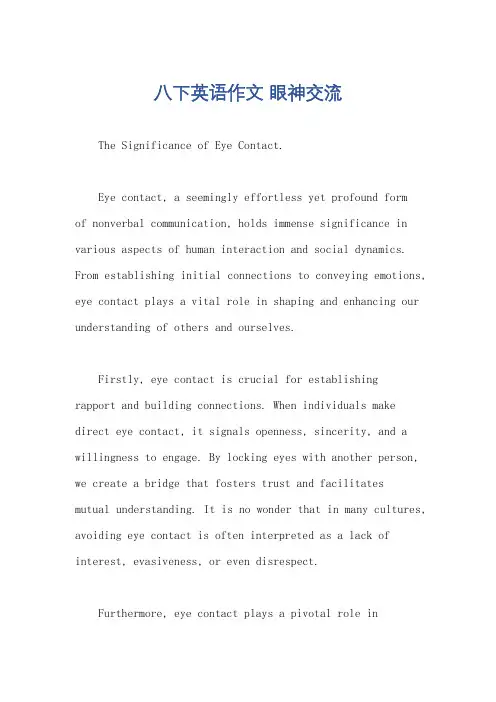
八下英语作文眼神交流The Significance of Eye Contact.Eye contact, a seemingly effortless yet profound formof nonverbal communication, holds immense significance in various aspects of human interaction and social dynamics. From establishing initial connections to conveying emotions, eye contact plays a vital role in shaping and enhancing our understanding of others and ourselves.Firstly, eye contact is crucial for establishingrapport and building connections. When individuals make direct eye contact, it signals openness, sincerity, and a willingness to engage. By locking eyes with another person, we create a bridge that fosters trust and facilitatesmutual understanding. It is no wonder that in many cultures, avoiding eye contact is often interpreted as a lack of interest, evasiveness, or even disrespect.Furthermore, eye contact plays a pivotal role inconveying and interpreting emotions. The intensity, duration, and direction of our gaze provide subtle yet powerful cues that reveal our inner feelings and intentions. Whether it is the warmth and affection conveyed through a lingering gaze or the discomfort and intimidation projected by a piercing stare, eye contact has the ability to express emotions without a single spoken word.In social situations, eye contact serves as a regulator of turn-taking during conversations. By alternating ourgaze between the speaker and the audience, we indicate our interest in the conversation and our willingness to participate. This subtle yet essential form of nonverbal communication ensures a smooth flow of interaction and prevents disruptions or misunderstandings.Moreover, eye contact has been shown to influence our cognitive processes and decision-making abilities. Studies have demonstrated that individuals who maintain eye contact during negotiations or persuasive conversations are more likely to be perceived as credible and trustworthy. This is because eye contact signals a sense of engagement,attention, and sincerity, which can positively impact outcomes.However, it is important to note that cultural normsand individual differences can affect the interpretation of eye contact. In some cultures, excessive eye contact may be interpreted as disrespectful or aggressive, while in others, it may be seen as a sign of confidence and assertiveness. Understanding these cultural variations and adjusting our eye contact accordingly is essential for effective communication across different contexts.In conclusion, eye contact is an indispensable aspectof human communication that shapes our interactions and enriches our understanding of others and ourselves. From building connections to conveying emotions, regulatingturn-taking to influencing cognitive processes, eye contact plays a multifaceted role in shaping our social experiences. By embracing the power of eye contact and utilizing it effectively, we can enhance our communication skills, build meaningful relationships, and navigate social situationswith greater confidence and understanding.。
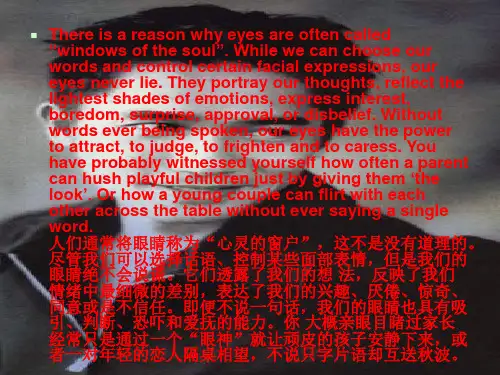
![口译演讲技巧[1]](https://uimg.taocdn.com/7039e004c77da26924c5b0bf.webp)
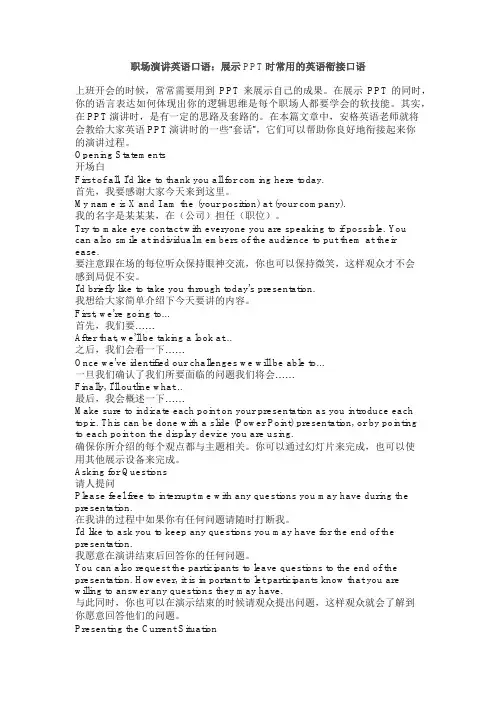
职场演讲英语口语:展示PPT时常用的英语衔接口语上班开会的时候,常常需要用到PPT来展示自己的成果。
在展示PPT的同时,你的语言表达如何体现出你的逻辑思维是每个职场人都要学会的软技能。
其实,在PPT演讲时,是有一定的思路及套路的。
在本篇文章中,安格英语老师就将会教给大家英语PPT演讲时的一些“套话”,它们可以帮助你良好地衔接起来你的演讲过程。
Opening Statements开场白First of all, I'd like to thank you all for coming here today.首先,我要感谢大家今天来到这里。
My name is X and I am the (your position) at (your company).我的名字是某某某,在(公司)担任(职位)。
Try to make eye contact with everyone you are speaking to if possible. Youcan also smile at individual members of the audience to put them at their ease.要注意跟在场的每位听众保持眼神交流,你也可以保持微笑,这样观众才不会感到局促不安。
I'd briefly like to take you through today's presentation.我想给大家简单介绍下今天要讲的内容。
First, we're going to...首先,我们要……After that, we'll be taking a look at...之后,我们会看一下……Once we've identified our challenges we will be able to...一旦我们确认了我们所要面临的问题我们将会……Finally, I'll outline what...最后,我会概述一下……Make sure to indicate each point on your presentation as you introduce each topic. This can be done with a slide (Power Point) presentation, or by pointing to each point on the display device you are using.确保你所介绍的每个观点都与主题相关。
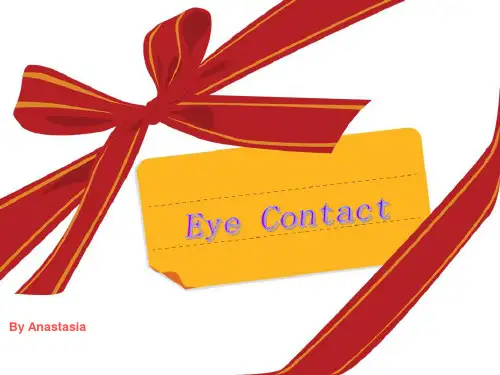
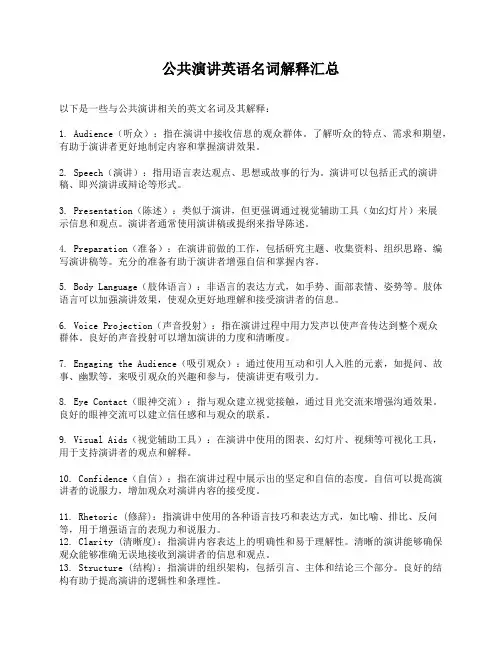
公共演讲英语名词解释汇总以下是一些与公共演讲相关的英文名词及其解释:1. Audience(听众):指在演讲中接收信息的观众群体。
了解听众的特点、需求和期望,有助于演讲者更好地制定内容和掌握演讲效果。
2. Speech(演讲):指用语言表达观点、思想或故事的行为。
演讲可以包括正式的演讲稿、即兴演讲或辩论等形式。
3. Presentation(陈述):类似于演讲,但更强调通过视觉辅助工具(如幻灯片)来展示信息和观点。
演讲者通常使用演讲稿或提纲来指导陈述。
4. Preparation(准备):在演讲前做的工作,包括研究主题、收集资料、组织思路、编写演讲稿等。
充分的准备有助于演讲者增强自信和掌握内容。
5. Body Language(肢体语言):非语言的表达方式,如手势、面部表情、姿势等。
肢体语言可以加强演讲效果,使观众更好地理解和接受演讲者的信息。
6. Voice Projection(声音投射):指在演讲过程中用力发声以使声音传达到整个观众群体。
良好的声音投射可以增加演讲的力度和清晰度。
7. Engaging the Audience(吸引观众):通过使用互动和引人入胜的元素,如提问、故事、幽默等,来吸引观众的兴趣和参与,使演讲更有吸引力。
8. Eye Contact(眼神交流):指与观众建立视觉接触,通过目光交流来增强沟通效果。
良好的眼神交流可以建立信任感和与观众的联系。
9. Visual Aids(视觉辅助工具):在演讲中使用的图表、幻灯片、视频等可视化工具,用于支持演讲者的观点和解释。
10. Confidence(自信):指在演讲过程中展示出的坚定和自信的态度。
自信可以提高演讲者的说服力,增加观众对演讲内容的接受度。
11. Rhetoric (修辞):指演讲中使用的各种语言技巧和表达方式,如比喻、排比、反问等,用于增强语言的表现力和说服力。
12. Clarity (清晰度):指演讲内容表达上的明确性和易于理解性。
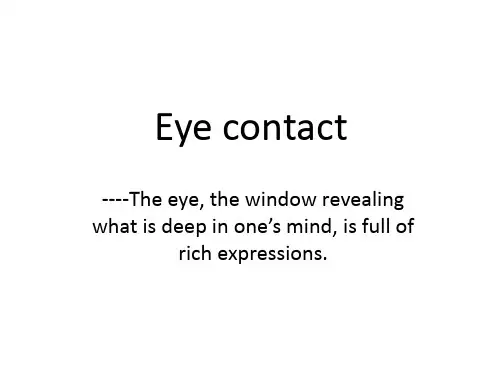
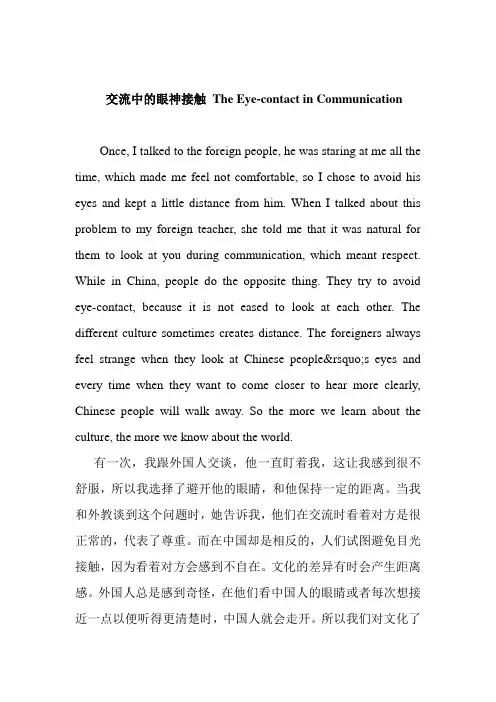
交流中的眼神接触The Eye-contact in CommunicationOnce, I talked to the foreign people, he was staring at me all the time, which made me feel not comfortable, so I chose to avoid his eyes and kept a little distance from him. When I talked about this problem to my foreign teacher, she told me that it was natural for them to look at you during communication, which meant respect. While in China, people do the opposite thing. They try to avoid eye-contact, because it is not eased to look at each other. The different culture sometimes creates distance. The foreigners always feel strange when they look at Chinese people’s eyes and every time when they want to come closer to hear more clearly, Chinese people will walk away. So the more we learn about the culture, the more we know about the world.有一次,我跟外国人交谈,他一直盯着我,这让我感到很不舒服,所以我选择了避开他的眼睛,和他保持一定的距离。

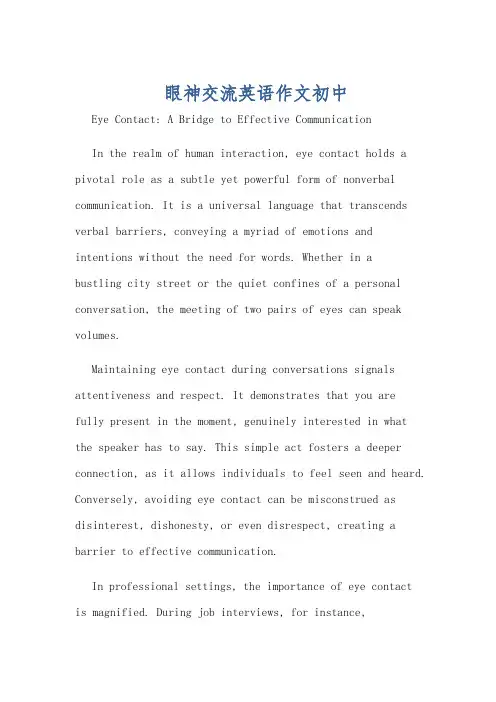
眼神交流英语作文初中Eye Contact: A Bridge to Effective CommunicationIn the realm of human interaction, eye contact holds a pivotal role as a subtle yet powerful form of nonverbal communication. It is a universal language that transcends verbal barriers, conveying a myriad of emotions and intentions without the need for words. Whether in abustling city street or the quiet confines of a personal conversation, the meeting of two pairs of eyes can speak volumes.Maintaining eye contact during conversations signals attentiveness and respect. It demonstrates that you arefully present in the moment, genuinely interested in what the speaker has to say. This simple act fosters a deeper connection, as it allows individuals to feel seen and heard. Conversely, avoiding eye contact can be misconstrued as disinterest, dishonesty, or even disrespect, creating a barrier to effective communication.In professional settings, the importance of eye contactis magnified. During job interviews, for instance,maintaining steady eye contact with the interviewer conveys confidence and sincerity, enhancing the candidate's credibility. Similarly, in presentations, speakers who engage their audience through direct eye contact tend to be more persuasive and memorable, as this connection helps establish trust and rapport.However, it is crucial to note that cultural norms play a significant role in interpreting eye contact. In some cultures, prolonged eye contact may be considered impolite or aggressive, while in others, it is a sign of honesty and openness. Thus, being culturally aware and adjusting one's behavior accordingly is essential to avoid misunderstandings.Moreover, the art of eye contact extends beyond simple attention; it involves the delicate balance between too much and too little. Staring intently can make others uncomfortable, while fleeting glances may indicate nervousness or lack of confidence. The key lies in finding a natural rhythm that feels respectful and engaging without crossing into intrusiveness.In summary, eye contact serves as a vital tool in fostering understanding and empathy between individuals. By mastering this subtle art, we can enhance our interpersonal relationships, improve our communication skills, and navigate diverse social and professional environments with grace and effectiveness.---眼神交流:通往有效沟通的桥梁在人类交往的领域中,眼神交流扮演着一个微妙而强大的非言语沟通角色。
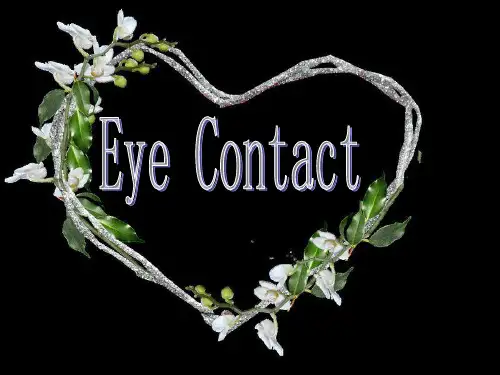
eye contact眼神接触(眼睛接触眼神接触)眼睛接触眼神接触嘿,来看看他们的眼睛。
这是好的事情做。
谁在乎电影里男演员做什么?嘿夜光9:直视她们的眼睛,这是做一件够胆的事。
谁管商业片里男演员做了什么?这是我的一个老帖子:这是我的一个老帖:我问我的一个女朋友:“你为什么要跟他出去?”和她他回答说:“因为当我看着他时,他一直和我保持眼神接触。
”我问我的一个女性朋友”你为什么跟他出去?”,她答曰:“因为当我看他时他一直跟我眼神接触”当我回忆起那些非常成功的人时,我感到很高兴。
在企业界工作,我记得他们都和我说话时保持眼神接触。
当你看着某人成功地在电视上采访,像太阳的Scott McNealy,你注意到他们从不从面试官的目光中移开,他们很少眨眼.当我想起在社团里我乐于为之工作的成功人士,我记得他们在对我说话时都保持眼神接触。
当你看电视里访问一些成功人士时,象太阳的Scott McNealy,你注意到他们眼神从不离开访问者的眼睛,而且他们很少眨眼。
当你走向对方时,你在大厅里接近一个女孩。
你应该什么时候看她?(她的眼睛,傻乎乎的)。
如果你看任何东西其它的都结束了)我试过所有的组合。
如果我等到最后瞬间,我要么发现她没有看,要么,如果她在看,她迅速移开视线。
如果我看着她,她看着我,我就会离开,然后她再也不看了。
然后我尝试了大胆的东西,然后决定一直看着她的眼睛。
令我吃惊的是,她像鹿一样注视着我。
在前大灯。
永不中断眼神交流。
所以我决定试试这个实验。
你在走廊遇到一个女孩此时你们正朝对方走着,你应该什么时候看她?(她的眼睛,傻瓜。
如果你看其它任何地方就完了。
)我已经试了各种组合。
如果我等到最后一刻,我要么发现她没看我或者如果她正看着我然后很快地看别处;如果我看她,她看我然后我看别处,那么她不会再看我。
后来我大胆尝试决定整个过程看她的眼睛,令我惊讶的是她象鹿盯桅灯一样盯着我。
决不中断眼神接触。
所以我决定试试这个小试验。